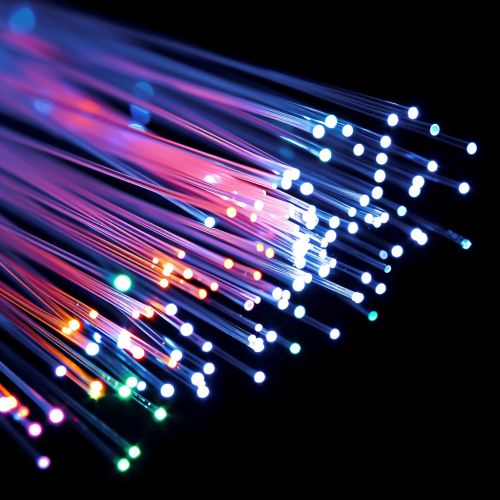Optical fiber communication
Introduction
Optical fiber communication is a method of transmitting information from one place to another by sending pulses of light through an optical fiber. The light forms an electromagnetic carrier wave that is modulated to carry information. The main benefits of optical fiber communication in comparison to traditional copper wire transmissions are its high data capacity (bandwidth) and low signal loss.
History
Harold Hopkins and Narinder Singh Kapany of Imperial College in London achieved low-loss light transmission through a 75 cm long bundle of optical fibers in 1954. This marked the first demonstration of the fundamental principle of optical fiber and laid the foundation for the future of optical fiber communication.


Principle of Operation
The operation of an optical fiber communication system primarily involves three steps: transmission of light signals through the fiber, optical amplification, and signal detection.
Transmission of Light Signals
The transmission of light signals through the fiber is achieved by using a laser diode or a light-emitting diode (LED). The light source is modulated by the data signal and then launched into the fiber.
Optical Amplification
Optical amplification is necessary because the signal undergoes attenuation as it travels through the fiber. The most common type of optical amplifier used in fiber-optic communication systems is the erbium-doped fiber amplifier (EDFA).
Signal Detection
The detection of the optical signal is carried out by a photodetector, which converts the optical signal back into an electrical signal. The most common type of photodetector used in fiber-optic communication systems is the avalanche photodiode (APD).
Types of Optical Fibers
There are two main types of optical fibers used in fiber-optic communication systems: single-mode fibers and multimode fibers.
Single-Mode Fibers
Single-mode fibers have a small core diameter, typically around 9 micrometers. They allow only one mode of light to propagate, which minimizes the distortion of the signal as it travels along the fiber.
Multimode Fibers
Multimode fibers have a larger core diameter, typically 50 or 62.5 micrometers. They allow multiple modes of light to propagate, which can lead to signal distortion over long distances.
Applications
Optical fiber communication is used in a wide range of applications, including telecommunication networks, cable television networks, and internet networks. It is also used in medical imaging and sensors, and in military and space applications.
Advantages and Disadvantages
Like any technology, optical fiber communication has its advantages and disadvantages.
Advantages
The main advantages of optical fiber communication are its high bandwidth, low signal loss, and immunity to electromagnetic interference. It also allows for long-distance communication, as the signal can travel large distances without significant attenuation.
Disadvantages
The main disadvantages of optical fiber communication are the high cost of the fiber and the equipment required for its use, and the difficulty of installation and maintenance. Additionally, optical fibers are fragile and can be damaged by physical stress or extreme temperatures.
Future Trends
The future of optical fiber communication lies in the development of new technologies and materials. These include photonic crystal fibers, which have the potential to significantly increase the bandwidth of optical communication systems, and silicon photonics, which could enable the integration of optical and electronic functions on a single chip.
